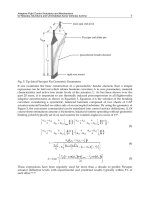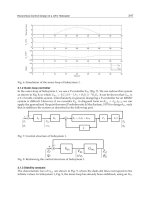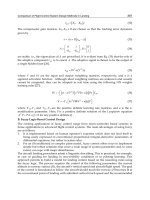Advances in Vehicular Networking Technologies Part 1 doc
Bạn đang xem bản rút gọn của tài liệu. Xem và tải ngay bản đầy đủ của tài liệu tại đây (3.46 MB, 30 trang )
ADVANCES IN
VEHICULAR NETWORKING
TECHNOLOGIES
Edited by Miguel Almeida
Advances in Vehicular Networking Technologies
Edited by Miguel Almeida
Published by InTech
Janeza Trdine 9, 51000 Rijeka, Croatia
Copyright © 2011 InTech
All chapters are Open Access articles distributed under the Creative Commons
Non Commercial Share Alike Attribution 3.0 license, which permits to copy,
distribute, transmit, and adapt the work in any medium, so long as the original
work is properly cited. After this work has been published by InTech, authors
have the right to republish it, in whole or part, in any publication of which they
are the author, and to make other personal use of the work. Any republication,
referencing or personal use of the work must explicitly identify the original source.
Statements and opinions expressed in the chapters are these of the individual contributors
and not necessarily those of the editors or publisher. No responsibility is accepted
for the accuracy of information contained in the published articles. The publisher
assumes no responsibility for any damage or injury to persons or property arising out
of the use of any materials, instructions, methods or ideas contained in the book.
Publishing Process Manager Katarina Lovrecic
Technical Editor Teodora Smiljanic
Cover Designer Martina Sirotic
Image Copyright Monkey Business Images, 2010.
Used under license from Shutterstock.com
First published March, 2011
Printed in India
A free online edition of this book is available at www.intechopen.com
Additional hard copies can be obtained from
Advances in Vehicular Networking Technologies, Edited by Miguel Almeida
p. cm.
ISBN 978-953-307-241-8
free online editions of InTech
Books and Journals can be found at
www.intechopen.com
Part 1
Chapter 1
Chapter 2
Chapter 3
Chapter 4
Chapter 5
Chapter 6
Chapter 7
Chapter 8
Chapter 9
Preface IX
Wireless Networks 1
Seamless Connectivity Techniques
in Vehicular Ad-hoc Networks 3
Anna Maria Vegni, Tiziano Inzerilli and Roberto Cusani
Asynchronous Cooperative Protocols
for Inter-vehicle Communications 29
Sarmad Sohaib and Daniel K. C. So
Efficient Information Dissemination in VANETs 45
Boto Bako and Michael Weber
Reference Measurement Platforms
for Localisation in Ground Transportation 65
Uwe Becker
Coupling Activity and Performance Management
with Mobility in Vehicular Networks 77
Miguel Almeida and Susana Sargento
Ultra-Wideband Automotive Radar 103
Akihiro Kajiwara
An Ultra-Wideband (UWB) Ad Hoc Sensor Network for Real-
time Indoor Localization of Emergency Responders 123
Anthony Lo, Alexander Yarovoy, Timothy Bauge,
Mark Russell, Dave Harmer and Birgit Kull
Hybrid Access Techniques
for Densely Populated Wireless Local Area Networks 149
J. Alonso-Zárate, C. Crespo, Ch. Verikoukis and L. Alonso
Hybrid Cooperation Techniques 165
Emilio Calvanese Strinati and Luc Maret
Contents
Contents
VI
Adaptative Rate Issues in the WLAN Environment 187
Jerome Galtier
An Overview of DSA via Multi-Channel MAC Protocols 201
Rodrigo Soulé de Castro, Philippe Godlewski and Philippe Martins
Distance Estimation based on 802.11 RTS/CTS
Mechanism for Indoor Localization 217
Alfonso Bahillo, Patricia Fernández, Javier Prieto, Santiago
Mazuelas, Rubén M. Lorenzo and Evaristo J. Abril
Data Forwarding in Wireless Relay Networks 237
Tzu-Ming Lin, Wen-Tsuen Chen and Shiao-Li Tsao
Experiments of In-Vehicle Power Line Communications 255
Fabienne Nouvel, Philippe Tanguy, S. Pillement and H.M. Pham
Kinesthetic Cues that Lead the Way 279
Tomohiro Amemiya
Transmission Technologies and Propagation 295
Technological Trends of Antennas in Cars 297
John R. Ojha, René Marklein and Ian Widjaja
Link Layer Coding for
DVB-S2 Interactive Satellite Services to Trains 313
Ho-Jin Lee, Pansoo Kim, Balazs Matuz, Gianluigi Liva,
Cristina Parraga Niebla, Nuria Riera Dıaz and Sandro Scalise
Mobility Aspects of Physical Layer
in Future Generation Wireless Networks 323
Asad Mehmood and Abbas Mohammed
Verifying 3G License Coverage Requirements 339
Claes Beckman
Inter-cell Interference Mitigation
for Mobile Communication System 357
Xiaodong Xu, Hui Zhang and Qiang Wang
Novel Co-Channel Interference Signalling
for User Scheduling in Cellular SDMA-TDD Networks 389
Rami Abu-alhiga and Harald Haas
Demodulation Reference Signal Design
and Channel Estimation for LTE-Advanced Uplink 417
Xiaolin Hou and Hidetoshi Kayama
Chapter 10
Chapter 11
Chapter 12
Chapter 13
Chapter 14
Chapter 15
Part 2
Chapter 16
Chapter 17
Chapter 18
Chapter 19
Chapter 20
Chapter 21
Chapter 22
Pref ac e
It’s fair to say that the array of commercially available vehicles is beginning to catch
up with the technological advances made available by science during the past decade.
With a lot of eff ort being employed by manufactures to provide cars with advanced
networking capabilities, we can mainly distinguish the connectivity topologies in two
very diff erent groups: the Vehicular Ad-hoc Networks (VANETs), which make use of
the scientifi c contributions provided by the Mobile Ad-Hoc Networks (MANETs), and
the Vehicle Infrastructure Integration (VII) based networks. VII or Vehicle-to-Infra-
structure (V2I) deserved special a ention during the last couple of years, in part, due
to the increase of interest on Cloud based communications, but also given the current
highlight over the paradigm shi towards the Internet of Things. Nevertheless, the
scope of technological challenges that have an immediate impact on the design and
performance of such specifi c networks is extremely wide and particularly diverse.
This book provides an insight on both, the challenges and the technological solutions of
several approaches, which allow connecting vehicles between each other and with the
network. It underlines the trends on networking capabilities and their issues, further
focusing on the MAC and Physical layer challenges. Mobile oriented technologies set
up the basic requirements for high mobility scenarios. Having this in mind, particular
a ention was paid to the propagation issues and channel characterization models.
We tried to cover a vast multitude of topics, which refl ect the current state of the art
concerning Vehicular Networking Technologies, some of which include dealing with
connectivity issues, networking topologies (VANETs, VII/V2I), MAC solutions, data
forwarding, network/vehicle performance management, link layer coding techniques,
mobile/radio oriented technologies, channel characterization and channel coding
amongst others.
We are thankful to all of those who contributed to this book and who made it possible.
We hope others can enjoy it as much as we do.
Miguel Almeida
University of Aveiro
Portugal
Part 1
Wireless Networks
1
Seamless Connectivity Techniques
in Vehicular Ad-hoc Networks
Anna Maria Vegni
1
, Tiziano Inzerilli
2
and Roberto Cusani
2
1
University of Roma Tre, Department of Applied Electronics, Rome,
2
University of Rome Sapienza, Department of Information Engineering,
Electronics and Telecommunications, Rome,
Italy
1. Introduction
Emerging Vehicular Ad-hoc NETworks (VANETs) are representing the preferred network
design for Intelligent Transportation Systems (ITS), mainly based on Dedicated Short-Range
Communications (DSRC) for Vehicle-to-Vehicle (V2V) communications (Held, 2007). Future
vehicles will be fully networked, equipped with on-board computers with multiple Network
Interface Cards (NICs) (e.g., Wi-Fi, HSDPA, GPS), and emerging wireless technologies (e.g.,
IEEE 802.11p, WiMax, LTE).
Although V2V is potentially the most viable approach to low-latency short-range vehicular
networks, connectivity in VANETs is often not available due to quick topology network
changes, random vehicle speed, and traffic density (i.e. sparse, dense, and totally
disconnected neighbourhoods) (Chiara et al., 2009). As an alternative, longer-range vehicular
connectivity are supported by a Vehicle-to-Infrastructure (V2I) protocol (Held, 2007), which
exploits a pre-existing network infrastructure, for communications between vehicles and
wireless/cellular access points (referred to Road Side Units, RSUs). As a further benefit, V2I
protocols allow access to the Internet and delivery of traditional applications in addition to
dedicated applications for ITS, thus making vehicle communications more versatile.
Both the paradigms —V2V and V2I— exhibit connectivity problems. Different speed and
traffic densities result in low vehicular contact rate, and limit communications via V2V
protocol, while V2I communications are reduced, especially in highway scenarios, by the
low number of RSUs displaced on the roads. Moreover, V2I limitations are due to particular
vehicular applications, and performance is also strictly dependent on the specific wireless
technology for the RSUs. It can then become advantageous to adopt hybrid schemes
combining V2V and V2I communication into a single protocol and allowing fast migration
from V2I to V2V connectivity depending on the operation context (high/low density,
high/low velocity). Such mechanism is the so-called Vertical Handover (Pollini, 1996).
In this chapter we shall describe the traditional techniques —Vertical Handover
algorithms— used for seamless connectivity in heterogeneous wireless network
environments, and in particular adopt them in VANETs, where V2V and V2I represent the
main communication protocols. Section 2 deals with the basic features of Vertical Handover
(VHO) in the general context of a hybrid wireless network environment, and it discusses
how decision metrics can affect handover performance (i.e. number of handover
Advances in Vehicular Networking Technologies
4
occurrences, and throughput). Instead, Section 3 briefly introduces two proposed techniques
achieving seamless connectivity in VANETs. The first technique is a vertical handover
mechanism applied to V2I-only communication environments; it is presented in Section 4
via an analytical model, and main simulated results are shown in Subsection 4.1. The second
approach is described in Section 5. It addresses a hybrid vehicular communication protocol
(i.e. called as Vehicle-to-X) performing handover between V2V and V2I communications,
and vice versa. Subsection 5 illustrates how messages can be propagating via V2X, while
Subsection 6 shows the main phases of V2X algorithm and the simulation results. Finally,
we conclude this chapter in Section 6.
2. Vertical Handover mechanism
Next generation wireless networks adopt a heterogeneous broadband technology model in
order to guarantee seamless connectivity in mobile communications. Different network
characteristics are basically expected for different multimedia applications, and ubiquitous
access through a single network technology is not always guaranteed because of limitation
of geographical coverage. Moreover, since mobile applications require Quality-of-Service
(QoS) continuity in a ubiquitous fashion, cooperation of access networks in heterogeneous
environments is an important feature to assure.
A Vertical Handover (VHO) is a process preserving user’s connectivity on–the–move, and
following changes of network (Pollini, 1996). In this context, VHO techniques can be applied
when network switching is needed (i) to preserve host connectivity, (ii) optimize QoS as
perceived by the end user, and (iii) limit the number of unnecessary vertical handover
occurrences (i.e. the well-known ping-pong effect) (Inzerilli & Vegni, 2008).
VHO schemes can be classified on the basis of the criteria and parameters adopted for
initiating a handover from a Serving Network (SN) to a new Candidate Network (CN).
Namely, we can enlist the following main metrics whose monitoring can drive handover
decisions:
• Received Signal Strength (RSS)-based VHO algorithms: when measured RSS drops below
receiver sensitivity it denotes lack of connectivity which requires necessarily a VHO
(Ayyappan & Dananjayan, 2008); (Inzerilli & Vegni, 2008);
• Signal-to-Noise and Interference ratio (SINR)-based VHO algorithms: SINR directly
impacts achievable goodput in a wireless access network. A modulation scheme can
sometimes adapt transmission rate a channel coding scheme to measured SINR (Yang et
al., 2007); (Vegni et al., 2009);
• Multi-parameter QoS-based VHO algorithms: VHO algorithms can be based on the
overall quality assessment for the available networks obtained balancing various
parameters (Vegni et al., 2007); (Jesus et al., 2007);
• Location-based VHO algorithms: they estimate network QoS on the basis of the MT
location relatively to the serving access point (Kibria et al., 2005); (Wang et al. 2001);
(Kim et al., 2007).
In an RSS-based VHO approach, when the measured RSS of the SN drops below a
predefined threshold, the RSS of the monitored set of CNs is evaluated in order to select the
best network to migrate to. The authors in (Ayyappan & Dananjayan, 2008) adopt this basic
approach for VHO and evaluate the performance of a vertical handover mechanism that is
based on the RSS measurements. This approach represents the traditional handover and
simplest mechanism, which however does not aim to optimize communication performance.
Seamless Connectivity Techniques in Vehicular Ad-hoc Networks
5
Differently, the SINR-based approach (Yang et al., 2007) compares the received power
against the noise and the interference levels in order to obtain a more accurate performance
assessment, which brings about a slight increase of computational cost. SINR factor is
considered for VHO decisions, as it directly affects the maximum data rate compatible with
a given Bit Error Rate (BER). Therefore, when the SINR of the serving network decreases,
the data rate and the QoS level decrease too. As a consequence, a SINR-based VHO (Yang et
al., 2007) approach is more suitable to meet QoS requirements, and can be used to
implement an adaptive data rate procedure. RSS-based and SINR-based schemes are both
reactive approaches, which means that they aim to compensate for performance degradation
when this occurs, that is whenever either the RSS or the SINR drops below a guard
threshold. Moreover, we expect that a combination of different VHO decision metrics (i.e.
location information, RSS/SINR measurements, QoS requirements or monetary cost) can
generate most effective and correct VHO decisions (Vegni et al., 2009).
A Multi-parameter QoS-based VHO scheme has been illustrated in (Vegni, et al. 2007),
which is instead representative of a proactive approach performing regular assessment of
the QoS level offered by the current SN, as well as by other CNs. The proposed method
attempts to select the best CN at any time thus preventing performance degradation, and
sudden lack of connectivity. It can be based on the simultaneous estimation of a set of
parameters such as RSS, throughput and BER and in the subsequent evaluation of an
objective QoS metric, which is a function of such parameters. Its effectiveness is directly
dependent on the ability of the objective QoS metric to mimic subjective Quality-of-
Experience of the end-users, and on the accuracy of the assessment of the parameters on
which the metric is based. QoS-based VHO is well suited for multimedia applications like
real-time video streaming. As a drawback, preventive approaches may lead to high
handover frequency and hence lead to algorithmic instability, i.e. the so-called ping-pong
effect. A hysteresis cycle or a hard limitation in maximum handover frequency in the VHO
algorithm can help reducing this phenomenon (Kim et al., 2007).
In location-based VHO solutions, the knowledge of location information is exploited to
assess the quality of the link between SN and the MT, and to predict its future evolution to
some extent on the basis of the MT estimated path. User position can be determined in
several ways (Kibria et al., 2005), including Time of Arrival, Direction of Arrival, RSS, and
assisted GPS (Global Positioning System) techniques. Examples of location-based VHO are
discussed in (Wang et al. 2001), though the proposed technique shows a computational
complexity of the handover decision that is rather high, and establishing and updating a
lookup table to support a handover margin decision turns out to be time-consuming. In
(Kibria et al., 2005) the authors develop a predictive framework based on the assumption
that the random nature of user mobility implies an uncertainty on his/her future location,
increasing with the extension of the prediction interval.
Location-based VHO solutions are the most commonly-used techniques in the VANET
context, where high-mobility of nodes makes it difficult to promptly react to performance
degradation purely basing on RSS measurements.
3. Seamless connectivity in vehicular ad hoc networks
In this section we are introducing two different approaches for seamless connectivity in
VANET scenarios.
The first approach is a Vertical Handover technique based on vehicle speed, where a vehicle
switches from a Serving Network (SN) to a Candidate Network (CN) if its speed is lower
Advances in Vehicular Networking Technologies
6
than a fixed threshold (Vegni & Esposito, 2010); (Esposito et al., 2010). Such technique i.e.,
called as Speed-based Vertical Handover (S—VHO) mainly addresses necessary
connectivity switching in vehicular environments for real-time applications, which require
high QoS levels and seamless connectivity. S—VHO does not consider traditional vehicular
protocol (i.e. V2V and V2I), but it simply guarantees a seamless connectivity when vehicles
are crossing an area with overlapping wireless networks.
The problem of a seamless connectivity becomes more challenging in VANETs, because
vehicles move across overlapping heterogeneous wireless cells environments. In such
scenarios, frequent and not always necessary switches from a SN to a CN may occur, often
degrading network performance. Vertical Handover techniques are able to fix seamless
connectivity according to a well-defined decision criteria (i.e. the type of RSU technology,
the RSS indicator, QoS metrics, and so forth (McNair & Fang, 2004)).
Traditional VHO decision metrics cannot be applied in vehicular environments, and may
fail due to the speed and the time that the vehicle is going to spend in a wireless network.
The problem of a seamless connectivity becomes even more challenging as vehicles move at
high speed across overlapping heterogeneous wireless cells environments.
Therefore, in VANETs handovers should be performed on the basis of specific factors, such
as vehicle mobility pattern, and locality information, rather than standalone QoS
requirements. Past solutions have partially but not fully considered these aspects. In (Chen
et al., 2009) the authors deal with a novel network mobility protocol for VANETs, to reduce
both handover delay and packet loss rate. In (Yan et al., 2008) a vertical handover technique
focuses on an adaptive handover mechanism between WLAN and UMTS, based on the
evaluation of a handover probability, obtained from power measurements. In this case, the
handover decision is taken by comparing the handover probability with a fixed probability
threshold, which depends on the vehicle speed and on handover latency.
The second technique is a hybrid vehicular communication protocol, called as Vehicle-to-X
(V2X), which achieves the advantages of both traditional V2V and V2I protocols (Vegni &
Little, 2010). V2X supports VANET scenarios with a heterogeneous network environment,
and aims for vehicles (i) to communicate between them (via V2V), and (ii) to connect to the
Internet (via V2I). V2X permits hybrid vehicular communications, and each vehicle can
switch from V2V to V2I, and vice versa, on the basis of a protocol switching decision metric.
We will illustrate the behaviour of V2X protocol, and analyze how information is
propagated in VANETs with heterogeneous network infrastructure nearby. In the simulated
scenarios, a data push communication model has been assumed, in which information
messages are propagated via localized (limited range) broadcast. Effectiveness of V2X will
be validated via a performance comparison —in terms of message dissemination— with
traditional opportunistic networking technique (i.e., V2V).
V2X results in a novel opportunistic forwarding technique that is the main approach to
achieve connectivity between vehicles, and to disseminate information. In traditional
opportunistic networking V2V communications exploit connectivity from other
neighbouring vehicles by a bridging technique, where message propagation occurs through
connectivity links which are built dynamically (Agrawal & Little, 2008). Each vehicle acts
as next hop and subsequent hops form a path from a source vehicle to a destination
vehicle. Because V2X does not rely only on V2V but also exploits the potentiality of V2I, it
should be considered as an opportunistic forwarding technique, where messages are
propagated along dynamically generated paths whose links are vehicles, as well as road
side units.
Seamless Connectivity Techniques in Vehicular Ad-hoc Networks
7
4. Speed-based VHO technique
A Speed-based VHO technique (S-VHO) is now described in each single step of VHO
decision (Vegni & Esposito, 2010). We recall that, as all the VHO techniques are mainly
focused on maximization of network performance, and limitation of vertical handover
occurrences, even for S-VHO the aim is to both minimize VHO frequency—the number of
executed VHOs— and maximize the throughput measured at the vehicle.
Differently from traditional RSS-based vertical handover approaches (Inzerilli & Vegni,
2008), the proposed S-VHO method does not consider any signal strength parameters: such
information might be out of date, unreliable and its variance may fluctuate significantly,
especially in VANET scenarios, causing unnecessary and unwanted vertical handovers, as
well as throughput degradation. With respect to traditional VHO algorithms, S-VHO takes
a vertical handover decision on the basis of the estimation of the cell crossing time
parameter, which represents the time spent in crossing a wireless cell by the vehicle. No
RSS indicator is considered in such approach, and S-VHO decides to switch from a SN to a
CN on the basis of throughput experienced at the vehicle receiver, and the time spent by
the vehicle in a CN.
It is noticeable that S-VHO method approaches to the technique proposed in (Yan et al.,
2008), except that S-VHO focuses on a vehicle-controlled VHO, due to smart on-board
computer equipped with GPS connectivity, and handover decisions are based on both
vehicle speed, and handover latency (Vegni & Esposito, 2010); (Esposito et al., 2010).
Moreover, S-VHO differs from previous vertical handover techniques because its usefulness
is extended to real time applications for vehicular scenarios (i.e., video streaming, on-line
gaming, Internet browsing, and so on).
We shall describe an analytical framework of S-VHO technique. First, we depict how
throughput in both serving and candidate networks can be estimated; then we show
analytically how a vertical handover decision is taken by the vehicle.
Figure 1 illustrates the vehicular scenario we are dealing with. We assume that a vehicle is
driving at constant speed v [m/s], following a typical Manhattan mobility model, suitable
for a urban area and where the vehicle’s trajectory is constrained by a road grid topology,
with straight paths (i.e. a highway composed of straight lanes). Each vehicle is equipped
with a GPS receiver, and then the vehicle’s location is continuously updated and tracked.
Let us denote as t
in
and t
out
the time instants when a vehicle enters and exits a wireless cell
(i.e. an UMTS network), respectively. The distance the vehicle will cross inside the wireless
cell during the time interval ∆T = t
out
— t
in
is:
v
x
T
.Δ=
Δ
(1)
From (1) we can introduce the Cell Crossing Time [s] parameter, according to the following
assessment, such as:
Definition (Cell Crossing Time). Given a vehicle V, traversing an area covered by a wireless cell
C at constant speed v
, the cell crossing time of V in C, denoted as ∆T [s], is the overall time that V
can spend under C’s coverage.
According to Figure 1, the cell crossing time lasts since the vehicle enters the wireless cell in
P
in
at t
in
, and then exits the wireless cell in P
out
at t
out
, respectively. During ∆T interval, the
vehicle is crossing the ∆x distance. Assuming an omni-directional radio coverage C for the
wireless network, and denoting (i) R ∈ ℜ
+
\{0} as the radius of the wireless cell, (ii)
φ
∈[0, π]
Advances in Vehicular Networking Technologies
8
as the angle between the vehicle’s line-of-sight with the RSU and the direction of the vehicle,
we can use classic Euclidean geometry to obtain
xR2cos.
φ
Δ
= (2)
Fig. 1. VANET scenario where a vehicle moves at constant speed v, following a Manhattan
mobility model. P
in
and P
out
are the wireless cell entrance and exit points, respectively
Since we have assumed that each vehicle is equipped with a GPS receiver, the coordinates
P
in
≡ (x
in
; y
in
) of the entrance, and P
out
≡ (x
out
; y
out
) of the exit point of the wireless cell, with
respect to a coordinate system centered in the cell centre, are easily calculated so that ∆x is
known. It follows that the cell crossing time can be expressed as
out in
out in
yy
xR
T
vv xx
2
cos arctan .
⎡
⎤
⎛⎞
−
Δ
Δ= =
⎢
⎥
⎜⎟
−
⎢
⎥
⎝⎠
⎣
⎦
(3)
Notice that the computation in (3) is directly performed by the vehicle by assuming constant
vehicle speed, and knowledge of the wireless cell radio coverage.
Fig. 2. VANET scenario with heterogeneous overlapping wireless networks
After defining geometric parameters, we can introduce the throughput Θ (t) [Bits],
evaluated for t = ∆T [s], as:
SN
tBT() ,
Θ
=Δ (4)
Seamless Connectivity Techniques in Vehicular Ad-hoc Networks
9
where B
SN
[Bit/s] is the bandwidth of the actual wireless cell (i.e. Serving Network, SN),
assumed to be constant during ∆T. Equation (4) defines the throughput Θ that a vehicle
would experience by remaining connected with the actual wireless cell, during the cell
crossing time ∆T.
Note that so far we have only modelled the throughput in a VANET network where a
vehicle is crossing a single wireless network, and no overlapping cells are considered. We
now extend the model to heterogeneous environments by capturing vertical handovers
across different access networks as well. In this case, a vehicle is entering an area where two
or more different wireless cells are co-existing and overlapped.
Figure 2 shows this vehicular scenario with heterogeneous overlapping wireless networks
(i.e. UMTS, and WLAN).
Namely, the vehicle drawn in Figure 2 is actually connected to an UMTS network, and is
entering a WLAN network in P
in
at t
in
. Then, UMTS represents a Serving Network (SN)
while WLAN a Candidate Network (CN), respectively.
Since S-VHO aims to maximize throughput, system initiates a handover from the SN (i.e.
UMTS) to the CN (i.e. WLAN), if and only if the estimated throughput measured in the CN
is higher than the throughput in the current SN, such as:
CN SN
Θ
≥Θ . (5)
Let a vehicle be connected to a SN, entering the wireless range of a Candidate Network
(CN). In this heterogeneous scenario, we model the data delivered between the two time
instants t
in
and t
out
, as a positive range function
γ
: ℜ → ℜ
+
defined as
(
)
(
)
(
)
CN SN
BTL BT1,
γα δ α
=
⋅−Δ−+− Δ (6)
where
α
is an indicator function, such that
α
= 1 when a vertical handover is executed, and
zero otherwise. Note that when
α
= 1,
γ
is equivalent to the throughput obtained in the CN,
while for
α
= 0,
γ
is the throughput in the SN. The parameter
δ
∈ ℜ
+
is a hysteresis factor
introduced to avoid vertical handover occurrence when the two competing networks have
negligible bandwidth difference.
Function in (6) captures the data loss due to the vertical handover latency L [s], that is the
time interval during which a vehicle, traversing an area covered by at least two wireless
cells, does not receive any data due to control plane (socket switching) signalling messages
exchange.
Since during the cell crossing time of a vehicle it is desirable to maximize throughput, S-
VHO technique initiates a handover only when it represents a valid handover, that is when
(
)
(
)
10
γα γα
=
>=, (7)
from which it follows:
SN
CN
B
B
L
T
1
δ
>+
−
Δ
, (8)
The inequality in (8) shows that switching decisions may not be necessary even though the
bandwidth
B
CN
is higher than B
SN
. Switching becomes necessary only if the time that the
Advances in Vehicular Networking Technologies
10
vehicle will spend in the wireless cell with higher bandwidth is long enough to compensate
for the data loss due to the switching overhead, namely only if
L
LT
T
10 .
−
>⇒<Δ
Δ
(9)
This observation leads to the conclusion that the throughput Θ is influenced not only by the
bandwidth of the considered technologies, but by a larger set of parameters, such as (i) the
cell crossing time, (ii) the vehicle speed, and (iii) the overhead of the control-plane protocols
adopted (handover latency). This consideration represents not only a novel definition for
throughput by three previous parameters (i.e. cell crossing time, vehicle speed, and
handover latency), but also gives an important result for vertical handover management and
connectivity switching decisions in vehicular networks. By monitoring and limiting vehicle
speed to a fixed upper bound, it is always possible to perform a valid handover. This result
represents the following Theorem of Speed Upper Bound for valid VHO decisions (Esposito et
al., 2010).
Theorem (Speed Upper Bound). Given a vehicle V, travelling with an average constraint speed v
in a heterogeneous vehicular environment for a distance ∆x, a valid handover for V occurs if
v
is
bounded as follows:
(
)
()
CN SN
CN
xB B
v
BL
.
δ
δ
Δ−−
<
−
(10)
Proof: the claim follows from (8), where we highlighted the term ∆T, such as
()
()()
()()
()
()
CN SN
CN SN
CN SN CN
CN
CN SN
L
BB
T
BTLBT
BB TB L
BL
T
BB
1,
,
,
.
δ
δ
δδ
δ
δ
⎛⎞
−−>
⎜⎟
Δ
⎝⎠
−Δ−>Δ
−−Δ> −
−
Δ>
−−
(11)
By replacing the term ∆T from (11) in the following definition of average vehicle speed, i.e.
vxT/,
=
ΔΔ
(12)
we obtain the result expressed in (10).
The Theorem of Speed Upper Bound is useful not only for VHO management, but also in
designing V2I protocols, as well as to promote vehicle safety applications. Network
providers may in fact offer lower data rate in those areas where the speed limit is lower, and
so induce vehicles to maintain lower speeds, in order to experience acceptable QoS levels —
low jitter and high throughput— throughout valid handovers. Users should be more
motivated to respect speed limits, rewarded by QoS enhancement.
S-VHO technique is based on Theorem 1 in order to manage valid handovers for fast users
driving in an heterogeneous vehicular network environment. This approach is acted by the
vehicle itself each time is crossing a wireless network and needs to be connected with it. S-
Seamless Connectivity Techniques in Vehicular Ad-hoc Networks
11
VHO rules according to the following algorithm drawn in Figure 3. S-VHO accepts three
inputs, such as (i) the vehicle speed v
, (ii) the ingress time t
in
of the vehicle into a wireless
cell, and (iii) the GPS location information P
in
, respectively. The algorithm then returns the
handover decision variable
α
∈{0, 1}, whose value means if a vertical handover is executed
or not.
Let a vehicle be connected to a SN, driving in an area with heterogeneous overlapping
wireless networks (i.e. UMTS, and WLAN). Due to multi-network interface cards equipping
the vehicle, it is able to recognize one or more available CNs to access. A vertical handover
can occur whenever the inequality in (8) is verified.
After each handover execution, the algorithm enters in idle mode for an inter-switch waiting
time period (i.e. T
w
[s]), that means no vertical decision is taken. For example, if a vehicle
travels at 15 m/s, a 10 seconds inter-switch waiting time results in 150 meters covered by
the vehicle, before the algorithm is reactivated. The idle mode approach is a well-know
solution for limitation of vertical handover frequency (Inzerilli & Vegni, 2008); (Inzerilli et
al., 2008).
()
in in
SN
CN
,,
,
1
evaluate
*
1 VHO executed
set a decreasing counter to [ ].
0
idle mo
w
w
vt P
inside area with at least two overlapped cells
B
B
L
T
T
TT
Ts
T
Input :
Output :
while do
if
then
if then
while do
α
δ
α
⎡⎤
⎢⎥
⎢⎥
>+
⎛⎞
⎢⎥
−
⎜⎟
⎢⎥
Δ
⎝⎠
⎣⎦
Δ
Δ>Δ
←
>
()
de
0 no VHO executed
end
else
end
end
end
α
←
Fig. 3. Speed-based Vertical Handover Algorithm
Many handover algorithms incorporate a hysteresis cycle within handover decisions, in
order to prevent a mobile terminal moving along the boundary of a wireless cell to trigger
handover attempts continuously. This phenomenon is well known in the literature as
ping-pong effect (Kim et al., 2007), and hysteresis is largely adopted in practical
implementations.
Advances in Vehicular Networking Technologies
12
A high number of vertical handover executions can lead to excessive network resource
consumption and also affects mobile terminal’s performance (i.e. battery life, and energy
consumption).
Ping-pong effect occurs in vehicular environments, specially when vehicles travel on a
border line between two wireless cells, and make frequent, often unnecessary or unwanted
handovers. Limitation of handover frequency is acted by imposing a minimum interval of
time between two consecutive handovers. Namely, the grater is the waiting time the smaller
will be the number of vertical handovers.
S-VHO algorithm first measures the data rate from CN (i.e. B
CN
), and then if inequality (8)
holds, the cell crossing time ∆T is computed as shown in (3). After the cell crossing time
evaluation, S-VHO decides whether the handover would be valid or not by comparing ∆T
with the threshold for valid handover, (i.e. ∆T*).
We can express the threshold for valid handover as
x
T
v
*.
*
Δ
Δ=
(13)
The term v* is the speed upper bound, obtained from the inequality (10) and formally
expressed as
(
)
()
CN SN
CN
xB B
v
BL
*,
δ
ε
δ
Δ−−
=
−
−
(14)
where
ε
is a positive quantity (i.e.
ε
→ 0). Equation (13) becomes
(
)
CN
CN SN
BL
T
BB
*.
δ
δ
−
Δ
−
−
(15)
The Theorem of Speed Upper Bound shows that the vehicle’s speed is strictly limited by
handover latency L, and the hysteresis factor
δ
. The impact of both two parameters and the
effects on the speed upper bound are described by the following analytical results.
In Figure 4 (a) we show the impact of the handover latency L [s] on the speed upper bound,
for a given bandwidth ratio of two available wireless technologies (e.g. UMTS, and WLAN
1
).
The hysteresis factor
δ
was set to zero to isolate only the impact of handover latency, and the
range of speed was bounded by 35 m/s (typical highway speed limit). As we can notice, for
higher values of handover latency, the speed upper bound (i.e. the maximum speed at
which vehicles experience valid handovers) decreases, and approaches to zero:
L
vlim * 0.
→∞
=
(16)
This result is reasonable since vehicles travelling at higher speed may not spend enough
time under higher data-rate wireless networks to justify the degraded performance
introduced by the handover overhead of the signalling messages.
For a bandwidth ratio equal to one (i.e. B
CN
= B
SN
), the speed bound is null as the hysteresis
factor has been set to zero; in general (i.e. for
δ
≠ 0), the speed bound is still approaching to
zero for L approaching to infinity:
1
The bandwidth ranges were chosen according to WLAN, and UMTS (Laiho et al., 2005) requirements.
Seamless Connectivity Techniques in Vehicular Ad-hoc Networks
13
()
LL
CN
x
v
BL
lim * lim
δ
δ
→∞ →∞
−Δ
=
−
. (17)
The second result comes by observing the epigraph and hypograph —the set of points
above, and below the drawn curves, respectively. Any point belonging to the epigraph
represents no performance gain in initiating handovers, even if the CN has higher
bandwidth than the SN. In contrast, for any point in the hypograph valid handovers occur.
We can notice that the curve with zero bandwidth gap (i.e. B
CN
= B
SN
) has empty hypograph.
This follows directly from the definition of valid handover, that means a vertical handover
cannot be valid when the data rates from CN and SN are equal.
(a) (b)
Fig. 4. Speed Upper Bound behaviour. Impact of (a) handover latency L, and (b) hysteresis
δ
In Figure 4 (b) we show the impact of the hysteresis
δ
[Mbps] on the speed bound, for
different values of the handover latency (i.e. L = {0.01, 0.02, 0.04, 0.08} [s]). The hysteresis
range is [0, B
CN
—B
SN
]. It is useful to note that B
CN
—B
SN
is the maximum value of
δ
after
which no valid handover would occur. We have simulated the case B
CN
—B
SN
= 16 [Mbps],
which represents a typical gap in data rates between UMTS and WLAN.
Fig. 5. Simulated VANET scenario with overlapping WLAN and UMTS cells
Advances in Vehicular Networking Technologies
14
Notice how the hypographic area changes for different values of L: the lower the handover
latency, the greater the hypograph. For example, when the handover latency increases (i.e.
L = 0.08 [s]), the hypographic area significantly reduces. From this observation, it follows
that handover latency should be taken into account when designing protocols for seamless
connectivity in VANETs, and not only focusing on physical parameters or vehicle speed.
4.1 S-VHO simulation results
In this section we describe some simulation results for S-VHO mainly expressed in terms of
throughput maximization, and limitation of ping-pong effect. They will show how S-VHO
works for valid vertical handovers in VANETs.
Network performance, i.e. throughput, delay, and jitter, as well as the number of vertical
handovers, have been obtained with an event-driven simulator. More details of the
simulator can be found in (Vegni, 2010). The simulation scenario depicts a vehicle entering
from a random location, restricted to travel along a grid of streets and intersections. The
vehicle follows a random path inside a grid, according to the Manhattan mobility model, as
shown in Figure 5. The event-driven simulator generates different scenarios, whose
characteristics are similar to previous heterogeneous scenarios described in (Vegni &
Esposito, 2010). Figure 5 depicts one of the simulated scenarios, in terms of data rate
distribution from a set of three UMTS base stations, and twenty WLAN access points,
modelling a 2 km
2
area.
The location of each wireless cell has been generated uniformly at random, and a vehicle
moves in this area with speed in the range [5, 35] [m/s], capturing urban environment as
well as highway scenarios. During its journey, a vehicle requires to download a series of
video frames. For example, we could figure out that passengers are enjoying their travelling
time by means of real time applications, e.g. video streaming and online gaming.
For the cell setup, we have considered typical values of WLAN and UMTS radio
parameters, as described in (Vegni & Esposito, 2010). The cell radius was set to 120 [m] for
IEEE 802.11/a outdoor environment, and 600 [m] for an UMTS microcell; the transmitted
power in the middle of UMTS and WLAN cell has been chosen to be between 43 and
30 dBm, respectively. Finally, the average vertical handover latencies from UMTS to WLAN,
and from WLAN to UMTS, have been set respectively to L
U
→
W
= 2 [s], and L
W
→
U
= 3 [s],
while the data rate of UMTS and WLAN equal to 384 [kbps], and 11 [Mbps], respectively.
S-VHO network performance have been validated in terms of (i) throughput, (ii) jitter, and
(iii) handover frequency. Moreover, a comparison between S-VHO and a previous vertical
handover technique (Yan et al., 2008), based on traditional power measurements, has been
carried out. In both algorithms, the speed of the vehicle is used as handover assessment
criterion. Hereafter we will name the technique described in (Yan et al., 2008) as Speed
Probability Based VHO (SPB). Simulated results
2
will prove the effectiveness of S-VHO for
valid handovers.
Figure 6 shows the throughput expressed as cumulative received bits in a downlink
connection for both S-VHO and SPB techniques, versus the inter-switch waiting time in the
range [0, 50] [s]. The cumulative received bits represent the amount of received bits by a
vehicle moving inside an heterogeneous wireless environment for the simulated period of
time.
2
Results obtained by averaging 100 heterogeneous network scenarios.
Seamless Connectivity Techniques in Vehicular Ad-hoc Networks
15
The throughput performance of S-VHO outperforms at every speed the SPB algorithm. Our
performance improvement are justified by the absence of received signal strength
dependence in S-VHO handover assessment criteria. Moreover, the effectiveness of S-VHO
is clear when vehicle speed is below a given limit (e.g., 20 [m/s]).
On the other hand, SPB does not appear sensitive to either speed or inter-switch waiting
time, and its throughput is limited. However, the S-VHO throughput drops when the
vehicle speed exceeds the desired limit. This is justified by the Theorem of Speed Upper
Bound for valid VHOs.
Fig. 6. Comparison of throughput between S-VHO (white markers), and SPB (black markers)
Fig. 7. Comparison of (left) delay, and (right) number of vertical handover occurrences,
between S-VHO (white markers), and SPB (black markers) algorithms
The average frame delay for both S-VHO and SPB is shown in Figure 7 (left). The 95%
confidence intervals express how the average frame delay increases for higher speeds. This
is because there is not enough time to download the next frame before the signal from the
SN gets too weak. Moreover, S-VHO experiences lower delays compared to SPB, since on
average it performs less handovers.









